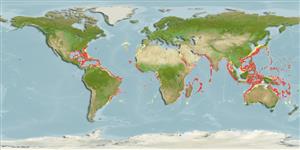>
Scombriformes (Mackerels) >
Scombrolabracidae (Longfin escolars)
Etymology: Scombrolabrax: Greek, skombros = mackerel + Greek, labrax, -akos = a fish, Dicentrarchus labrax (Ref. 45335).
Environment: milieu / climate zone / depth range / distribution range
Ökologie
seewasser benthopelagisch; ozeanodrom (Ref. 51243); tiefenbereich 100 - 900 m (Ref. 10817). Subtropical; 39°N - 35°S, 98°W - 168°E
Atlantic, Indian and Pacific: widespread in tropical and subtropical areas. Not occurring in the eastern Pacific and southeast Atlantic.
Size / Gewicht / Alter
Maturity: Lm ? range ? - ? cm
Max length : 30.0 cm TL Männchen/unbestimmt; (Ref. 6655)
Rückenflossenstacheln (insgesamt): 12; Rückenflossenweichstrahlen (insgesamt): 14-16; Afterflossenstacheln 2-3; Afterflossenweichstrahlen: 16 - 18; Wirbelzahl: 30. Body dark brown in color (Ref. 6655).
Oceanic and mesopelagic. Found on the continental shelf and underwater sea rises (Ref. 10817). Rather rare.
Life cycle and mating behavior
Geschlechtsreife | Fortpflanzung | Ablaichen | Eier | Fecundity | Larven
Parin, N.V., 1990. Scombrolabracidae. p. 973. In J. C. Quéro, J. C. Hureau, C. Karrer, A. Post and L. Saldanha (eds.) Check-list of the fishes of the eastern tropical Atlantic (CLOFETA). JNICT, Lisbon; SEI, Paris; and UNESCO, Paris. Vol. 2. (Ref. 10817)
IUCN Rote Liste Status (Ref. 130435)
Bedrohung für Menschen
Harmless
Nutzung durch Menschen
Fischereien: nicht kommerziell
Mehr Information
NamenSynonymeMetabolismusRäuberÖkotoxikologieFortpflanzungGeschlechtsreifeAblaichenSpawning aggregationFecundityEierEientwicklung
ReferenzenAquakulturAquakultur ProfilZuchtlinienGenetikElectrophoresesVererbbarkeitKrankheitenVerarbeitungNutrientsMass conversion
PartnerBilderStamps, Coins Misc.LauteCiguateraGeschwindigkeitSchwimmstilKiemenoberflächeOtolithsGehirngrößeSehfähigkeit
Tools
Zusatzinformationen
Download XML
Internet Quellen
Estimates based on models
Preferred temperature (Ref.
123201): 8.9 - 18.6, mean 12.9 °C (based on 628 cells).
Phylogenetic diversity index (Ref.
82804): PD
50 = 1.5000 [Uniqueness, from 0.5 = low to 2.0 = high].
Bayesian length-weight: a=0.01122 (0.00514 - 0.02450), b=3.04 (2.87 - 3.21), in cm total length, based on all LWR estimates for this body shape (Ref.
93245).
Trophic level (Ref.
69278): 4.0 ±0.65 se; based on food items.
Fishing Vulnerability (Ref.
59153): Low vulnerability (20 of 100).
